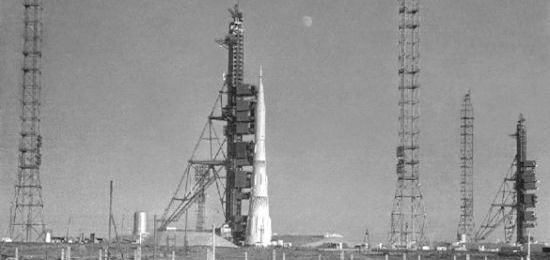On May 25, 1961, President Kennedy, addressed Congress and expressed his intention to commit the nation to achieving the goal of “landing a man on the Moon by the end of this decade and returning him safely to the Earth”.
Until then, the Soviet Union's excellence in space exploration was clearly evident.
In October 1957, Sputnik, the first artificial satellite, was launched, a month later the Laika dog became the first living being of this planet that traveled outside the atmosphere with Sputnik-2. In 1959, the Luna 3 probe sent the historic, first photo of the dark side of the Moon. Finally, on April 12, 1961, Yuri Gagarin became the first man in space.
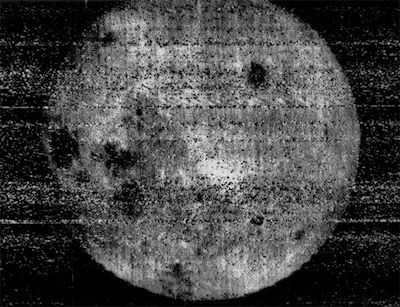 |
The Soviet successes, combined with the troubled US space program (Vanguard, Pioneer 1-4), had caused great concern in the newly established NASA (1958). Also, as space missions used essentially the same missile carriers with the ballistic nuclear weapons of the time, there were many concerns in the US about the possibility of an existing gap between the missile capabilities of the two countries.
In this context, President Kennedy, only a few weeks after the Bay of Pigs fiasco, set the next goal of the space adventure, knowing that a manned mission to the Moon could restore US prestige. In fact, a manned mission to the Moon at that time was completely premature and controversial in terms of scientific gains, but the aim was more political than scientific.
The story of the Apollo program is more or less well known. By the end of the 1980s, however, the Soviet Union had not recognized that there was a corresponding program for a manned mission to the Moon. During the 1990s, more and more evidence began to surface, concerning the Soviet efforts and the reasons that eventually did not allow cosmonauts to walk on the surface of the Moon.
Fragmentation of the Soviet Space Program
In the early 1960s there was no clear objective of the Soviet Space Program. The first striking successes had given their place to an uncertainty as to who should be the next target. In the Soviet Union there was no dedicated agency like NASA, and the design and implementation of the program was the result of cooperation, or better competition, between different design departments belonging to different government agencies and the Soviet Academy of Sciences, which had the responsibility of preparing the final recommendations to the Soviet leadership.
The most prominent figure of the Soviet space program was without a doubt Sergei Korolev, the father of almost all Soviet missiles until the mid-60s and the mastermind of the programs that developed the Sputnik, Luna, Venera and Vostok missions. In 1961, Korolev's team was asked to prepare plans for a carrier rocket, coded N-1, that could carry a payload of up to 80tn, to place in orbit a space station equipped with nuclear weapons. At the same time, Korolev was also completing the design of a spacecraft named Soyuz, whose mission was not yet certain. Soyuz was designed with the possible missions of an interplanetary journey (Moon or Mars), serving a space station, and even creating a modular space station by connecting 2 or more Soyuz capsules together.
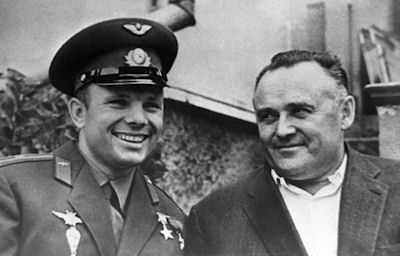 |
At the same time, another design bureau under Valentin Glusko was assigned the design of a space craft that would be able to carry out a mission around the Moon. Another program, Luna, was preparing unmanned probes that would orbit and surface on the Moon, initially to take photos and in a latter stage to collect surface samples with robots.
So while the US, with NASA as a central implementing body that has full and complete management of the space program, is channeling all resources and using all available technical and scientific potential to accomplish a single goal, in the USSR the space program is fragmented between different design offices, and many mission profiles. It is worth noting that while NASA is trying to determine the specifications and needs of the spacecraft that will transport astronauts to the Moon and from these to determine the requirements of a carrier rocket, the USSR's best space engineer’s (Korolev) energy and capabilities are exhausted in the construction of a monstrous missile whose mission has not yet been determined.
It was not until August 3, 1964, that the Central Committee adopted a resolution setting the goal of sending a cosmonaut to the moon in 1967-68, before Apollo's missions began. Over the next year, after intense competition and constant clashes between design offices, 3 programs for the Moon will be adopted and will be finally implemented by 3 different design offices:
- The office of Chelomey (OKB-52), with whom Glusko is now working, is called to undertake the manned mission around the Moon (code L-1).
- Korolev's office (OKB-1) is assigned to design a manned Moon landing mission, using the N-1 rocket and a 2 stage Soyuz craft (code L-3) for travel to the moon.
- The office of Babacin, which is specifically set up to manage the Luna program (of robot missions to the Moon), as Korolev no longer has time to deal with it.
So, in 1965, five years after Kennedy's proclamation, the Soviet space program for the Moon and all the related scientific, financial and material resources are divided in three directions. In addition, the two offices that have taken over the manned missions (OKB-1 and OKB-52) are in an open conflict, hardly exchanging any data.
Towards the Moon
An important milestone in the development of the manned Moon landing program was Korolev's death in January 1966. His assistant Missin took over, but the blow was heavy.
The Luna program was well ahead of the other two, having started earlier and being much less complex as it did not include manned flights, and began to deliver results. In February 1966 the Luna-9 became the first probe to achieve a soft landing on another planetary body transmitted photos from the Moon surface to Earth, while in April of that year Luna-10 completed a full rotation around the Moon.
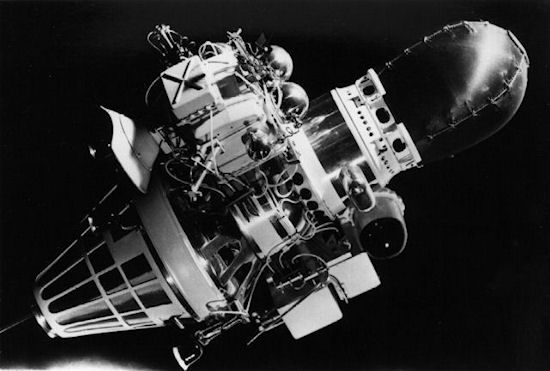 |
The L-1 program of the manned flight around the Moon was the next to enter the final phase. The L-1 consisted of a modified Soyuz craft and the rocket-propelled carrier Proto. A total of 15 L-1 capsules were built, only 2 of which were certified for human transport. The rest concerned test flights, scientific instruments and biological samples.
In the fall of 1968, an unmanned L-1, named Zod-5, completed a rotation around the Moon, causing worrying sensation in the Western world when the emission of a human voice was detected. In fact, it was a voice message used for calibrating the communication parameters with Earth. The Zod-6 mission that followed in November of the same year could have been a precursor to a manned flight, but the re-entry vehicle was decompressed, resulting in the death of the animals that were on board, acting as biological samples.
At the same time, in December 1968, NASA was preparing to launch the Apollo 8 that would transport the first astronauts around the moon. The planned Zod-7 manned launch was ultimately postponed due to the previous accident, despite the fact that the team of cosmonauts, with a letter to the Soviet leadership, demanded that the mission be carried out. So Borman, Lovell and Anders of Apollo 8 became the first people to "fly" around the Moon.
The Apollo 8 mission essentially ended the L-1 program, with only a few more unmanned flights following.
In early 1969, the first N-1 operational rocket launcher had been hoisted on the launch pad at the Baikonur Cosmodrome. It was a giant rocket with 30 engine nozzles at its base, and was the only one capable of carrying the pay- load of a Moon mission. Cosmonauts had been training since early 1968. But the L-3 spacecraft was not yet ready, due to the development problems of the Soyuz program, problems that were evident both from the unmanned L-1 missions and the individual Soyuz launch and re-entry tests. One of these tests had cost the life of cosmonaut Komarov in April 1967, when the re-entry vehicle crashed to the ground at a speed of more than 600 km/hr.
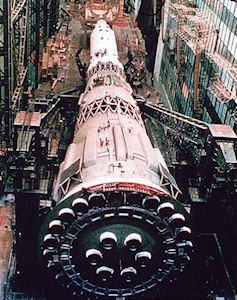 |
Unfortunately problems continued, as the first N-1 launch on February 21, 1969 failed, with the rocket catching fire 66 seconds after the launch. A second N-1 launch on July 3, 1969 was disastrous. Just 200 meters from the ground, the rocket exploded and fell to the ground, destroying both the main base launch pad and the nearby reserve pad. Baikonur was no longer capable of launching N-1 rockets. Repairs and reconstruction took two years.
In a desperate effort, on July 13, 1969, a Luna craft was launched in order to land on the Moon, before the scheduled Apollo 11 mission three days later. This mission had raised many questions and concerns in the US, as its nature and purpose were not exactly known. Fears extended to the possibility that the Soviets would try to interfere with Apollo 11. On July 21, 1969, the Soviet ship crashed on the surface of the Moon, and a few hours later Armstrong made his first historic steps.
The day after
The success of Apollo 11 and the destruction of the N-1 launch facilities in Baikonur essentially marked the end of the Soviet program for manned flights to the Moon. However, perhaps due to inertia, it would be four years before the plans were finally abandoned.
On the contrary, the Luna program should be considered rather successful as a number of robots, including vehicles on the surface of the Moon, had been able to send samples, photographs and other scientific data back to Earth. The last Luna expedition was launched in October 1976.
In 1971, after the reconstruction of the facilities at Baikonur, another launch of the N-1 resulted in failure, followed by another, the final one, in November 1972. The Soviet Union did not have a rocket carrier with sufficient transport capacity to implement a manned flight to the moon. After 1974 attention was focused to the evolution of the Energy rocket that would later be used to launch the Soviet space shuttle Buran.
Conclusions
If one wishes to dwell on the two main reasons that did not allow the Soviet Union to send humans to the Moon, before or after Apollo 11, it can distinguish them in two categories:
Technically the main problem was the inability to develop a reliable carrier rocket (N-1) that could carry the total weight of a manned landing mission. It is worth noting that thoughts were made of the use of a smaller, Proton rocket to launch 2 different vessels that would meet in Earth’s orbit, connect and then travel as one ship to the Moon. This plan encountered problems in the development of the Soyuz.
From a management point of view, two main issues can be recognized. The first is the fragmentation, both in objectives and resources. The second, and ultimately perhaps the most important in the race of the 2 superpowers towards the Moon, is summarized in the available funds: $ 4.5 billion for N-1, L-1, L-3 programs from the Soviet Union and $ 24 billion for the Apollo program from the US.




